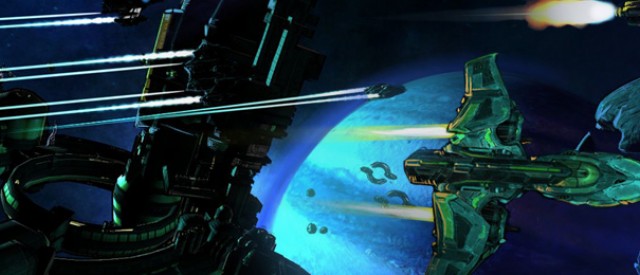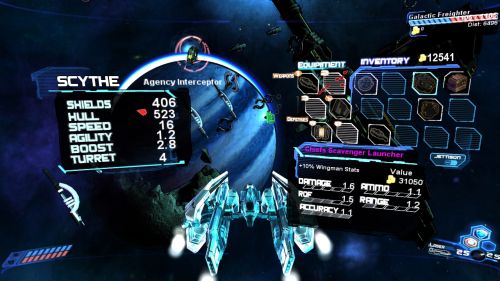

I remember sitting down at my parents’ computer when I was about 11 years-old, putting in an Origin games CD-ROM with Wing Commander 2 (and the original Syndicate), and blasting my way through the galaxy one Kilrathi at a time. It’s been ages since I’ve played space sims like that, so I was excited when I saw Dawnstar. Here, I thought, was a game that would take me back to those glorious days of my youth. Once again I’d be cutting my engines to let an enemy fighter fly past so I could lock onto him with my missiles. I’d be adjusting my shield levels to prepare for an oncoming frontal assault. Sadly, Dawnstar falls short of these ideals and often feels like more of an echo of the space sims that I grew up playing than a true revival. Oddly, though, I keep coming back to it.
The overall setting and universe into which Dawnstar places you feels good. Set in the distant future where space mafias and space police vie for control, the main story revolves around infiltrating one of the larger mafias whose capo is “one bad day away from declaring war..” There’s more than a little feeling of “Firefly” to all this, especially when characters mention things like “the core worlds” and the potential for the capo’s actions to lead to an outright revolt. It’s up to you (the generically named “Pilot”), a drunken ex-goodfella, and the undercover police agent that was originally assigned this mission, to breakup the mafia’s power and keep them from causing trouble. All of this unfolds comic-book style with illustrated panels and voice-acting depicting in between the main story missions.
Outside of those missions, the general comic-book aesthetic is maintained with some truly gorgeous hand-drawn, cel-shaded art. On more than one occasion I found myself absent mindedly flying around the different game zones (which are little more than hubs with space stations and a few ships) just enjoying the jazzy soundtrack and looking at the backgrounds. There needs to be more to the game than just graphics and story, though, and it’s in Dawnstar’s gameplay that problems arise.

For many of the story missions, you’ll go straight from the comic-book narrative to some place in space without any clue or indication of how you got there. Just “here you are, do this thing, ok, mission done!” If the game were structured so that this was the norm, i.e., story, mission, story, mission, then it would be fine. Yet, in order to start many of these story pieces that lead into a mission, you have to fly around in and jump through different sectors just to get to the right one where you can kick it all off. That’s wrong.
Part of the joy of any space sim is that sense of emptiness inherent to cruising through the vastness of space. When tasked to go to a specific sector/galaxy to intercept a few ships or take out an entire armada, the journey there is part of that experience. Who knows what may happen along the way? Maybe you’re ambushed by enemy fighters as a part of some overall set piece, or maybe you just decide you feel like taking on that seemingly weak battleship. Regardless, you’re forced to make choices that ultimately affect what you do when you finally come face-to-face with your primary objective and that’s part of what’s missing from Dawnstar: that sense of exploration and facing the unknown once you depart from the safety of a space station. This one piece could be overlooked as making the title a little more “arcade-y” if the other gameplay aspects were rock solid. Unfortunately, they’re not.
Once a mission gets going, the core gameplay mechanic of any space sim comes into full effect - the space-battle dogfight. More than anything else, the story, the graphics, or all the other trappings, this is where Dawnstar really needs to shine. Space combat is the very heart of this genre so controlling your ship needs to feel almost intuitive, and everything you need in order to tell your current state, where your enemy is, and what dangers you need to avoid, has to be readily available with a quick glance away from the action. In the case of Dawnstar, ship control is a bit off as certain maneuvers, such as a barrel roll or loop-the-loop, don’t do much other than look nice, and all of that critical information you need boils down to something of a guessing game.
What’s missing here, basically, is a good HUD and some actual defensive maneuvers. The HUD that’s currently in place shows the ships that are in the area but it’s incredibly hard to tell precisely where they are. Instead of a radar, there’s a circle sitting on top of your crosshairs with friendly and hostile dots that just roll around as you tilt and roll your ship. When you finally do locate your target, firefights in Dawnstar basically boil down to keeping your eye on the target and killing your target before all his incoming fire catches up to you. Missiles will hit you unless you speed up enough to get away from your foe, and that isn’t always a guarantee. Even if it does work, you’re left with tracking him back down again. This whole exercise becomes exponentially more difficult when faced with multiple foes all gunning for you, or unique-named foes that are tougher than your average space fighter and seem to have the kind of slick maneuvering that you should have.
Should you succeed in shooting your opponent down, you may find yourself rewarded with some better weapons and shields to equip or sell off in order to buy the aforementioned better gear. This is where the action RPG elements of the game start to find their way in and they are, for the most part, one of the more satisfying aspects of the game. In addition to the loot, you’ll also gain experience from your space kills which eventually earn you different skills and passive enhancements that can give you an upper hand in combat. They’re not as in-depth as Diablo 3 or Torchlight 2, but they definitely keep things interesting and fun.
The action-RPG elements carry over well into co-op play, too. The entirety of the game, which spreads across five chapters, can be played with up to three friends online. One player is the host and controls what sector the group goes to and starts missions, while the other players joining his or her game get to keep all loot and experience progress when they go back to their own. Once joined by your compatriots, enemies get a little tougher and they drop better loot, which is individual to each player. Better loot is always a good reason to play cooperatively, but the better reason (aside from the usual “it’s fun to play with friends”) is that it provides a solution to the previously mentioned targeting/maneuvering issues. When you get into a difficult situation, and don’t have a way of getting out real easy due to the lack of defensive maneuvers, having a few friends there to help shoot down harassing foes can make all the difference. The only real problem with co-op play is the connectivity issues. Connecting to a friend’s game can be tough as Dawnstar suffers from the usual firewall/allowing certain ports on the router issues that PC games not going through a major digital distribution service encounter these days. This can be fixed with a little bit of effort, but it does make embarking upon this journey with pals more of a concerted effort than a seamless integration.
It would be unfair to mention the issues Dawnstar faces without also mentioning that since the game’s release last Tuesday, the game has been patched 7 times. Most of these patches fixed little glitches with things like audio, or controls not working, but each includes something that’s in direct response from the feedback Wraith Entertainment has received on their forum. It’s a rather impressive amount of post-release work to be done on a new title and is a great sign of commitment to their IP. It gives me hope that much of the problems will be smoothed out eventually.
If you read back through what I’ve said so far, Dawnstar’s issues can seem rather incredible. A radar that only sort of helps. No way to avoid or even know when there are incoming enemy missiles. Poor targeting controls. Connectivity problems, audio/control glitches, and more. Yet in spite of all this, I still recommend playing this game if you’re a fan of space sims. The overall package, from the gorgeous cel-shaded graphics and jazz soundtrack to the basic gameplay, is enjoyable, fun, and worth the price of admission. It’s also a little more palatable when you know what you’re getting. The coffee table you purchased may not end up looking as advertised, but a board that sits on a couple of cardboard boxes still works. And, hopefully, those 3/8” screws and missing legs are in the mail.